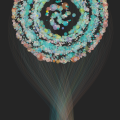Majestic Landscapes
Physical Souvenirs of Digital Data
Created for Majestic, a UK based company that analyses Internet data, Majestic Landscapes create physical representations of their link data that they then send to key clients.
Dixon Jones from Majestic explains:
We use the Internet so much, we miss the mathematical beauty within. We decided to capture that DNA and bring it into the real world. Every link profile is made up of thousands – or in Google’s case billions of links. Each link has its own Trust Flow and Citation Flow that we call Flow Metrics.
As 3ders.org explains:
The algorithm behind Flow Metrics denotes a Trust and Citation value between 0 and 100 to every link to your website, generating a cool 101 x 101 graph. Links with high Citation Flow end up more to the right, while links with more Trust Flow end up higher on the chart. In short, the more links that score a top-right result, the better your website is positioned on the web.
Rather than me spending time creating individual models for Majestic clients I instead created a bespoke piece of software that Majestic could then use to create these landscapes and then send to key clients as well as use them at industry trade shows and conferences.
As I say in the interview in Forbes:
I’m reminded of physical souvenirs that you might buy when on holiday. Souvenirs are often artifacts that are designed to remind you of an event, a journey or places you’ve been. So if you think about it they might represent a date or a period of time – which of course is data, though it’s data that’s not unique to you. By using 3D printing coupled with bespoke software it’s now possible to create such “souvenirs” to a highly detailed personal level and not just around events or time. They could represent for example your Fitbit progress for a year; imagine having this thing sat on your desk or on your shelf, ready to spark conversations about how you’ve been doing in your new exercise regime, or maybe it’s just a personal reminder to yourself of what you’ve achieved so far – a reminder that is always present, sat in a physical space rather than a digital one, yet it’s born from digital data. That’s just one example of how this could be used – there’s a thousand others when you start to think about data in physical form.











